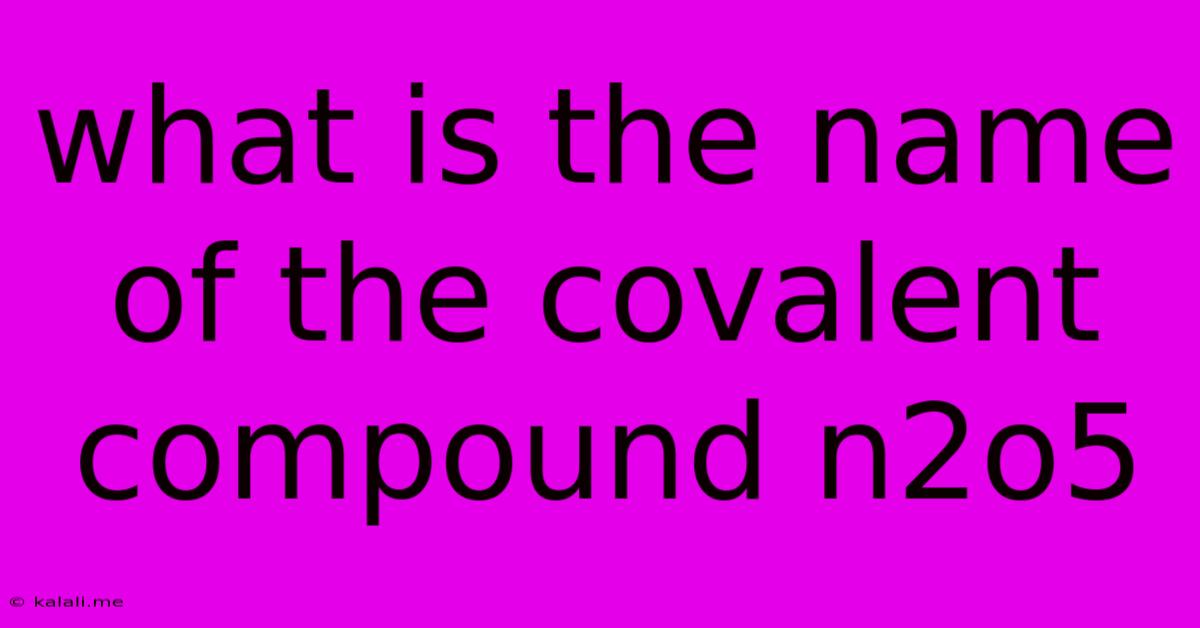What Is The Name Of The Covalent Compound N2o5
Kalali
May 10, 2025 · 3 min read

Table of Contents
What is the Name of the Covalent Compound N₂O₅?
Dinitrogen pentoxide is the name of the covalent compound with the chemical formula N₂O₅. This article will delve deeper into its properties, structure, and common uses, providing a comprehensive understanding of this important chemical compound. Understanding the nomenclature of covalent compounds like this is crucial in chemistry, and this guide will help solidify your understanding of how to name these compounds.
This seemingly simple chemical compound holds significant importance in various chemical processes. Its unique properties and reactivity make it a key player in several industrial and laboratory applications. Let's explore further.
Understanding Covalent Bonding in N₂O₅
Before diving into the specifics of dinitrogen pentoxide, it's important to understand what makes it a covalent compound. Covalent compounds form when atoms share electrons to achieve a stable electron configuration. In N₂O₅, nitrogen (N) and oxygen (O) atoms share electrons, resulting in a molecule held together by strong covalent bonds. Unlike ionic compounds, which involve the transfer of electrons, covalent compounds consist of molecules.
The prefixes "di" and "penta" in the name reflect the number of nitrogen and oxygen atoms respectively. "Di" indicates two nitrogen atoms, and "penta" indicates five oxygen atoms, accurately representing the chemical formula N₂O₅.
Structure and Properties of Dinitrogen Pentoxide
N₂O₅ exists in two forms: a colorless crystalline solid and a gas. The solid form is typically more stable. The structure of N₂O₅ is quite interesting; it’s a symmetrical molecule composed of two nitrogen atoms, each bonded to three oxygen atoms, where one oxygen atom bridges the two nitrogen atoms. This results in a unique arrangement of atoms with specific bond lengths and angles. It's crucial to note that its structure significantly influences its reactivity and behavior in chemical reactions.
Key properties of dinitrogen pentoxide include:
- Appearance: Colorless crystalline solid or gas
- Melting point: Relatively low melting point
- Solubility: Soluble in certain solvents
- Reactivity: A strong oxidizing agent; reacts violently with many organic compounds.
Uses of Dinitrogen Pentoxide
While its reactivity makes it potentially hazardous, dinitrogen pentoxide finds applications in several areas, primarily in:
- Nitration Reactions: It's used as a nitrating agent in organic chemistry, crucial for producing nitro compounds.
- Laboratory Reagent: It serves as a useful reagent in various chemical syntheses.
- Oxidizing Agent: Its strong oxidizing properties make it applicable in specific oxidation reactions.
Safety Precautions
Due to its strong oxidizing nature, handling dinitrogen pentoxide requires careful attention to safety protocols. Appropriate protective gear, including gloves and eye protection, is essential when working with this compound. It should be handled in a well-ventilated area to avoid inhaling its fumes. Avoid contact with organic materials to prevent potential hazardous reactions.
Conclusion
Dinitrogen pentoxide (N₂O₅) is a fascinating covalent compound with a unique structure and significant applications. Understanding its properties, structure, and safety precautions is vital for anyone working with this chemical. Its role in nitration reactions and other chemical processes highlights its importance in various scientific fields. Remembering the systematic naming convention, based on the number of atoms of each element, helps in correctly identifying and classifying this compound among others.
Latest Posts
Latest Posts
-
How Tall Is A 3 Story Building
Jul 03, 2025
-
Is Miranda Cosgrove Related To Jimmy Fallon
Jul 03, 2025
-
What Is 1 4 Of A 1 4 Cup
Jul 03, 2025
-
What Is 20 Percent Off Of 39 99
Jul 03, 2025
-
Where Is The 3 In Riddle Transfer
Jul 03, 2025
Related Post
Thank you for visiting our website which covers about What Is The Name Of The Covalent Compound N2o5 . We hope the information provided has been useful to you. Feel free to contact us if you have any questions or need further assistance. See you next time and don't miss to bookmark.